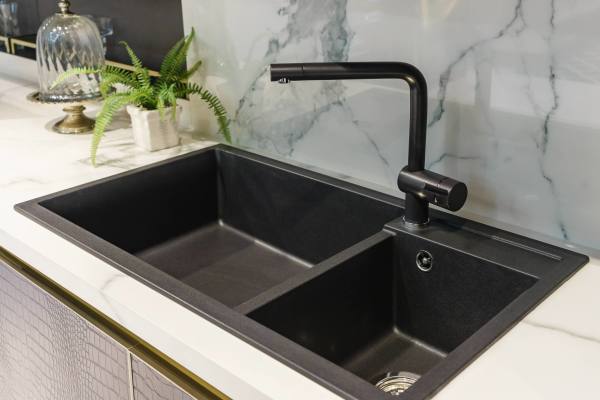Mould never sends an RSVP. It just shows up in your sink, lounging around puddles and food scraps like it owns the place.
Left unchecked, it can leave your kitchen smelling like a sponge that should’ve been binned a week ago.
Luckily, getting rid of it doesn’t take a hazmat suit or a shelf full of sprays—just a few smart habits and some everyday supplies. Want to know how to keep it from moving in? Let’s get into it.
Scrub Every Corner
The best way to show mould the door is with a solid deep clean. Think of it as a reset button for your sink.
You don’t need a cupboard full of fancy sprays either, since your pantry already has effective ingredients you can use.
Grab some baking soda and give the sink a light sprinkle. Then, pour vinegar over the top and watch it fizz, breaking down grime and loosening up mould spores.
Once the bubbling stops, grab a sponge and start scrubbing. Focus on the corners, around the faucet, and even the drain. When you’re done, rinse everything with warm water, then wipe it dry to get rid of leftover dampness.
Make this part of your weekly routine, and before long, your kitchen will stay fresh and mould-free.
Dry Your Sink
A freshly scrubbed sink is a good start, but if you leave water sitting there, you’ll be rolling out the welcome mat for mould.
After rinsing vegetables, finishing the dishes, or even running the tap briefly, water will cling to the surface and collect in corners where it is harder to see.
To avoid this, take a minute to dry your sink. A couple of swipes with a dry towel are all you need. Just focus on the spots where moisture tends to settle, like the areas around the drain, behind the handles, and near the seams.
If you want to make the habit easier, keep a cloth within arm’s reach. Hang one on the oven door or leave it near the sink, so you don’t have to rummage around for it.
Some people even keep a towel specifically for drying the sink, separate from the one they use on dishes. This way, you’ll always have a clean option ready to go.
Keep Leaks at Bay
Even with a spotless sink, mould can creep back if there is a leak nearby. Moisture from dripping pipes or loose fittings creates exactly the kind of damp environment it thrives in, and the space under your sink is one of the most common trouble spots.
Luckily, just a quick peek under your sink once a week should do the trick. Look for damp patches, staining, swelling, or any smell that suggests water is collecting where it shouldn’t.
If a small leak appears, grab some plumber’s tape and wrap the trouble spot. If it’s something bigger, though, it’s better to call in someone who knows what they’re doing.
Add a Sink Mat or Tray
Sometimes, no matter how careful you are, you may end up with some water puddles. That stray moisture is exactly what mould is waiting for, which is where a sink mat or tray can save the day.
Drop one next to the faucet or under the dish rack to catch those little splashes that usually get ignored.
Not all mats are made equal, though. Some fall apart after a few weeks, and others slide around and cause more trouble than they solve.
We recommend going for silicone or rubber. These last longer, stay in place, and don’t soak up water like fabric versions do. That means you won’t find hidden mould growing underneath.
Also, look for ones that are easy to clean. Some can be tossed straight into the dishwasher, while others just need a little soap and warm water. Either way, regular cleaning will keep them fresh.
Air It Out
Steam builds up fast after you boil pasta, wash the dishes, or make soup. All of it fills the air with moisture, and when that moisture lingers, mould starts looking for a place to settle in.
To clear the air, turn on an exhaust fan, let it run while cooking, and leave it on for 10 minutes afterwards. That’s usually enough to push out the dampness.
Just don’t forget to keep your fans clean. A greasy or dusty filter can’t pull moisture out effectively, so rinse it every now and then to keep your unit running at full power.
No fan? No problem. Just open a window. Even a small crack will let fresh air in, leaving your kitchen feeling lighter and less stuffy.
Declutter Your Under-Sink Cabinet
The space under your sink can often turn into a dumping ground for bottles, sponges, and random sprays. That clutter, especially when mixed with a little dampness, creates the perfect environment for mould to creep in.
Instead of stacking everything, store your items in airtight containers. Plastic tubs with lids work well for larger items, while glass jars or smaller boxes can hold your sponges, cloths, and brushes.
You should also go for clear containers to see everything you have at a glance and avoid ending up with forgotten bottles in the back corner.
Just make sure to check those bins every now and then. If something is leaking, clean it up before mould has a chance to spread. While you’re at it, go through your products and get rid of expired ones.
That said, if you’re short on time, there’s no shame in calling in a maid service. Life gets busy, and sometimes, the last thing you want to do is crawl around under the sink with a flashlight and a rag.
Many cleaning packages include quick checks of those hidden corners to stop moisture and leaks from becoming long-term headaches.
Conclusion
Who says your sink area has to be a scary no-go zone? Mould is sneaky, but it’s not clever enough to beat you.
By giving that space a quick once-over now, you’ll save yourself from dealing with slimy patches later. So, don’t wait, and show mould the door today.


